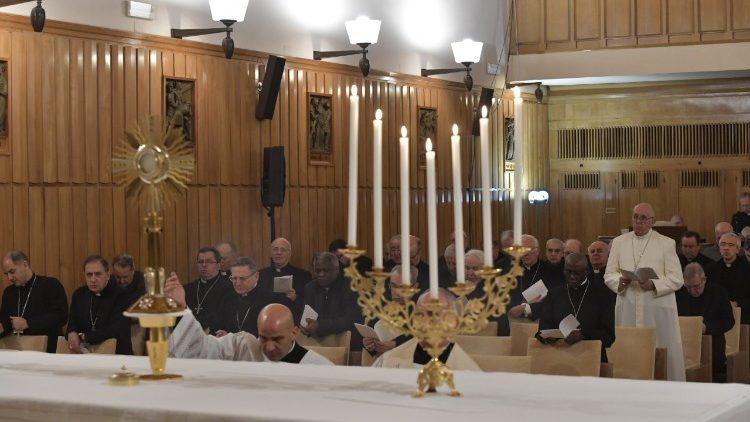
Spiritual exercises: Jesusâ Thirst and Womanâs Tears
By Sr Bernadette Mary Reis, fsp
âJesusâ thirst,â and âTears tell thirstâs storyâ are the titles of the reflections given by Fr Tolentino on Tuesday evening and Wednesday morning.
Jesus Thirsts
On Tuesday afternoon, Fr Tolentino took inspiration for his meditation using a verse from Johnâs Gospel: âAfter this, aware that everything was now finished, in order that the scripture might be fulfilled, Jesus said, âI thirstâ â (John 19:28). There are other occurrences in Johnâs Gospel that help us understand Jesusâ words: 1) When Jesus is thirsty and asks the Samaritan woman for a drink (John 4:13-15); 2) The declaration âwhoever believes in me will never thirstâ (John 6:35); and 3) The words of Jesus spoken in the temple during the Feast of Booths: âLet anyone who thirsts come to me and drinkâ (John 7:37). Fr Tolentino observes that Jesusâ âI thirstâ spoken from the cross in the present tense makes it âintense, current and uninterrupted. Jesus still says today âI thirstâ. This helps us understand how Jesus fulfills his destiny.â His mission being fulfilled, he says, âI thirst.â
Mother Teresa experienced Jesus' thirst
Mother Teresa, he says, experienced Jesusâ thirst in a mystical experience. âIn an almost physical way she felt Jesusâ thirst calling her to give her life in service to the thirst of the poor and rejected, to the poorest of the poor.â The gift given to us to satiate our thirst is the Holy Spirit, Father Tolentino reminds us. âWe are called to live even suffering, persecution, illness, and joyfully. We are called to live every situation with lively hope. Why? Because the Holy Spirit, Godâs strength, wind, breeze, breath, is in us.â
Women open the Gospels to us
The protagonists for Fr Tolentinoâs Wednesday morning meditation are the many women that populate Lukeâs Gospel. âThe women in the Gospel prefer to express themselves with gestures. Their faith seeks comfort through touchâtangible, emotional, disarming--rather than through abstraction,â he explains. Commenting on Lukeâs description of those following Jesus, Fr Tolentino points out that the way women accompanied the Lord was different than their male counterparts. âThe women âwere withâ Jesus exactly in the same way as the Twelve. They made his destiny their own destiny. But the text adds one thing regarding only them: âthey were serving Jesus.â The womenâs reaction is profoundly evangelical. They never ask Jesus the questions that the disciples ask him such as âLord, will only a few people be savedâ (Luke 13:23)? Or âLord, what must I do to inherit eternal life (Luke 10:25)? Their declarations are concrete such as, âBlessed is the womb that carried you and the breasts at which you nursedâ (Luke 11:27).
Womenâs faith
With women, there is a âripple of reality that intervenes in order to shape faith. In this way it does not remain a prisonerâas often happens to our faithârationalistic, lived mechanically according to doctrine or ritual.â It is because they are in touch with daily life that they give âperfume to the faith.â The women in Lukeâs Gospelâthe widow of Naim, the âsinner,â the women of Jerusalemâalso cry notes Fr Tolentino. St Gregory Nanzianzen describes these tears as a baptismâwhich many other saints have experienced. Fr Tolentino then concludes his meditation with the image of the woman washing Jesusâ feet with her tears. What this woman gave thus âserves Jesus as the litmus textâ for what the Pharisee ârefused to give.â âIt is this unheard of hospitality which Jesus wants to praiseâthat thirst, expressed in tearsâwhich is our turn to learn."
Thank you for reading our article. You can keep up-to-date by subscribing to our daily newsletter. Just click here






